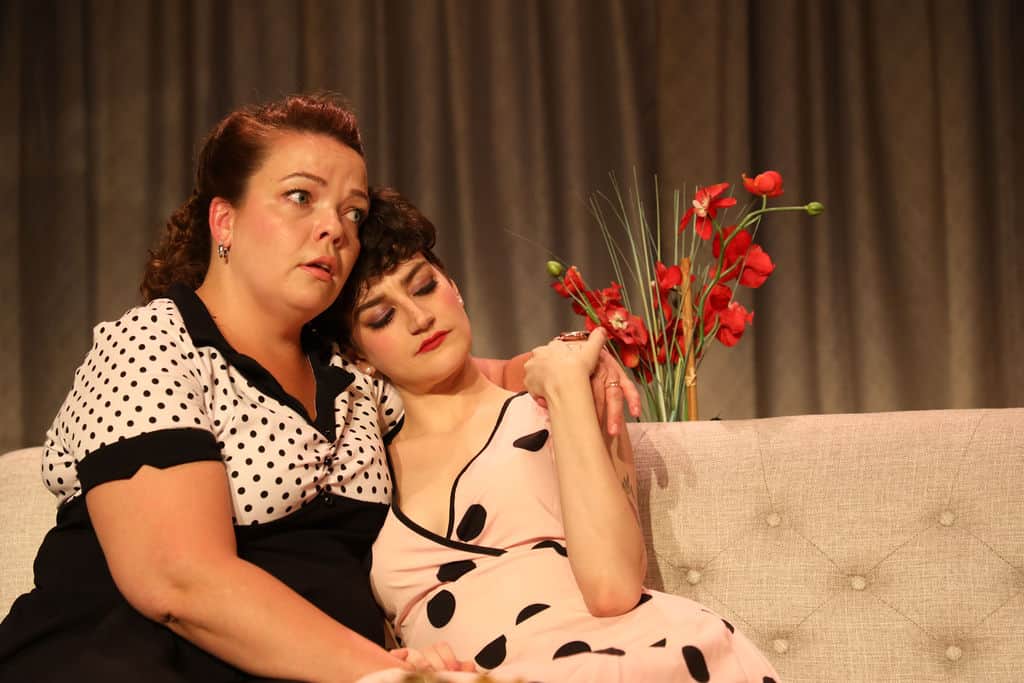From Farcical to Sombre in PERFECT ARRANGEMENT at Fells Point Corner Theatre

Posted on BroadwayWorld.com September 3, 2019
Being the age I am, I might well be the only person in the audience of the production of Topher Payne‘s Perfect Arrangement, now gracing the stage at Fells Point Corner Theatre, who can personally recall one of the historical events that inform the play. Though the play’s focus is on the “Lavender Scare,” which resulted in the purging of hundreds of State Department employees on suspicion of homosexuality, that scare was a companion to the “Red Scare,” which led to the purging of hundreds of State Department employees on suspicions of “disloyalty.” And indeed the play depicts the same people as implementing both scares, Lavender and Red. In 1953, my father, a senior diplomat administering the Marshall Plan, whose loyalty would in any rational world have been unquestionable, was let go in the Red Scare. And so the play resonated some for me. I can recall that as I came to understand what had become of our family, the thing that most struck me was the due process-deprived irrationality of it all. And for the characters in the play caught up in the toils of the Lavender Scare, that is the nub as well, the irrationality.
It’s no wonder the topic appealed to Payne, a prolific Atlanta-based playwright whose work largely focuses on gay themes. Dramatists have always put irrationality to good use. It can for instance serve as the mainspring of farce, as it certainly does here, particularly in the first act. The title Perfect Arrangement refers to the compact of a male gay couple and a lesbian couple to hide in plain view from the disapproval of the world in 1950 by posing as two straight couples living in adjoining halves of a Georgetown duplex. The two halves are secretly connected through the residences’ respective front closets, a passage that enables each real couple to reunite at night, unnoticed by the world outside. Such a setup is custom-made for farce. So there is plenty of dashing into and out of the closet or hiding under furniture, of excuses ginned up on the fly to explain when one or other of the “neighbors” is in the “wrong” house while the people expected to be there are elsewhere. To add to the comic as well as the ideological tension, one of the “husbands” and one of the “wives” are together placed in charge of implementing the State Department’s purges, paradoxically opening themselves up to retaliatory revelations by their victims. Farce (of a grim sort).
In most farces, though, at the end, after the audience’s tension has been ratcheted up by the accumulating lies and cascading improbabilities, all the impostures must come tumbling down. Shams will be unmasked, and the world will readjust. And that convention, the unmasking, is observed in Perfect Arrangement as well. Except that there’s nothing funny or farcical about what happened to “unmasked” employees of the State Department in 1950. (The first U.S. diplomat to have exited the closet and kept his career seems to have come out in 1975.) As a result, both history and the dynamics of farce compel a shift in tone between the first and the second acts of the play.
To be candid, I could not entirely follow what does and doesn’t happen after the unmasking moment in the play, but it is clear that one of the central characters decides to burrow deeper into the (metaphorical, not the literal) closet while the others make a choice to be truer to themselves and resolve to agitate publicly for change.
I don’t think the majority choice was actually available in 1950. Dudley Clendinen and Adam Nagourney, in Out for Good, their authoritative history of “the struggle to build a gay rights movement in America,” begin in 1969 with Stonewall, although they note in passing that there had been demonstrations throughout the 60s, which had been “small, rare, respectful, even timid, with the men wearing ties and jackets and the women in skirts.” But the events of the play take place at the dawn of the 50s, not even the 60s.
A choice to exit the closet in official Washington of the 50s or 60s would likewise have been career suicide; the actual suicide of Senator Lester Hunt in 1954 when Hunt was threatened with being outed (which inspired the fictional suicide of a senator in the sensational book Advise and Consent (1959) and movie made of it (1962)) gives a more accurate picture of the unendurable fearfulness of the condemnation characters would have had to expect had they come out.
But whatever the historical accuracy of depicting people of that place and time choosing to be publicly and unapologetically explicit about who they were, it works dramatically – as does the related exploration of complicity and self-hatred of gay public servants who participated in gay witch-hunts. The change in tone of the play’s second act makes this thoughtful and dramatically challenging exploration possible. That said, one can be grateful to have had the laughs of Act One first.
FPCT gives the resulting show, both funny and thoughtful, a rousing production. As the two queer characters in charge of purging queer characters, Nate Krimmel and Holly Gibbs are portraits in dismay, and between them they credibly explore the range of emotional development likely for people in their situation. And Ari Eckley and Gabe Fremuth, as their spouses, are good with the comedy and, particularly in Eckley’s case, good at the more sensitive stuff, for instance conveying the emotional groundwork on which a character in those circumstances might build the decision to come out. Ebony N. Jackson and Shamire Casselle portray two very different intruders on the seclusion crucial to the Perfect Arrangement. Jackson’s character, deep into the kind of housewifery promoted by the postwar media, is anxious to drag the other women along into a life focused on maternity and consumption, her form of sisterhood obliviously threatening the women’s lesbian lives. Jackson imparts just the right kind of insistent cluelessness into the role. Casselle’s character is more complicated; of uncertain sexual orientation but apparently prodigious sexual appetite, and unburdened by shame, she turns out to be both prey and predator to the witch-hunters and their mates. Casselle wrings a lot of laughs out of a part which remains in large measure mysterious and unknown. While, for reasons I’ve already given and others, I’m not convinced that this is truly a story of the middle of the last century, any suspension of disbelief I managed was largely due to David Forrer’s turn as a senior State Department official in charge of wrangling the witch hunters. He effortlessly evoked the WASPy and patrician State Department I remember around my parents. And the rest of the suspension of disbelief would be owing to Bruce Kapplin’s set, a terrific evocation of Mad Men era decorative values.
To paraphrase John Lennon, an amusing and thought-provoking time is guaranteed for all.
Copyright (c) Jack L. B. Gohn, except for production photo.
Photo credit: Shaelynn Jae Photography

 I lived in London and Vienna before coming to the United States, and grew up mainly in Ann Arbor. I was writing plays and stories as early as grade school. My undergraduate years at the University of Pennsylvania, where I first reviewed theater, for the college paper, were succeeded by graduate study at the Johns Hopkins University, where I earned a doctorate in English Literature.
I lived in London and Vienna before coming to the United States, and grew up mainly in Ann Arbor. I was writing plays and stories as early as grade school. My undergraduate years at the University of Pennsylvania, where I first reviewed theater, for the college paper, were succeeded by graduate study at the Johns Hopkins University, where I earned a doctorate in English Literature.